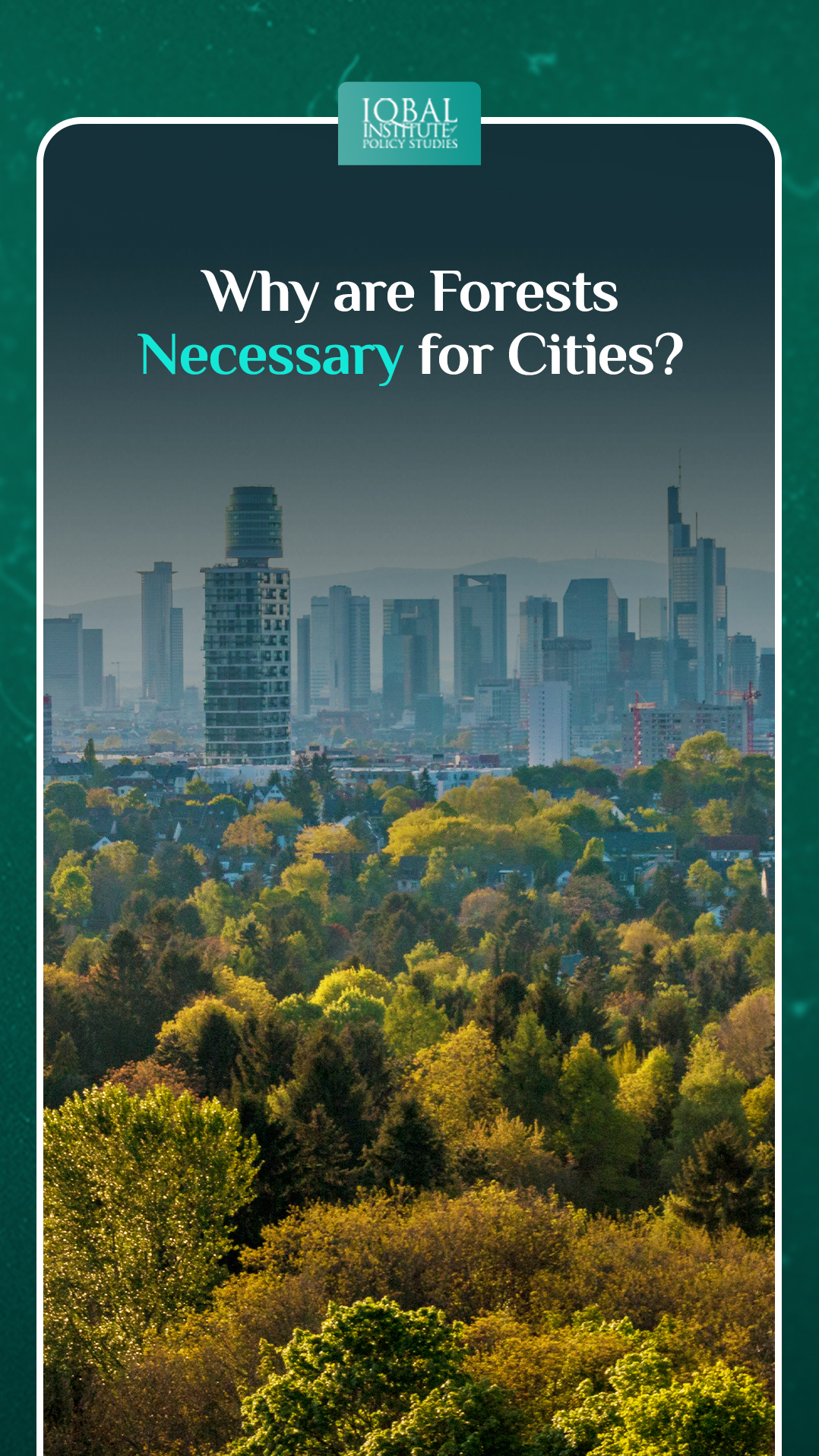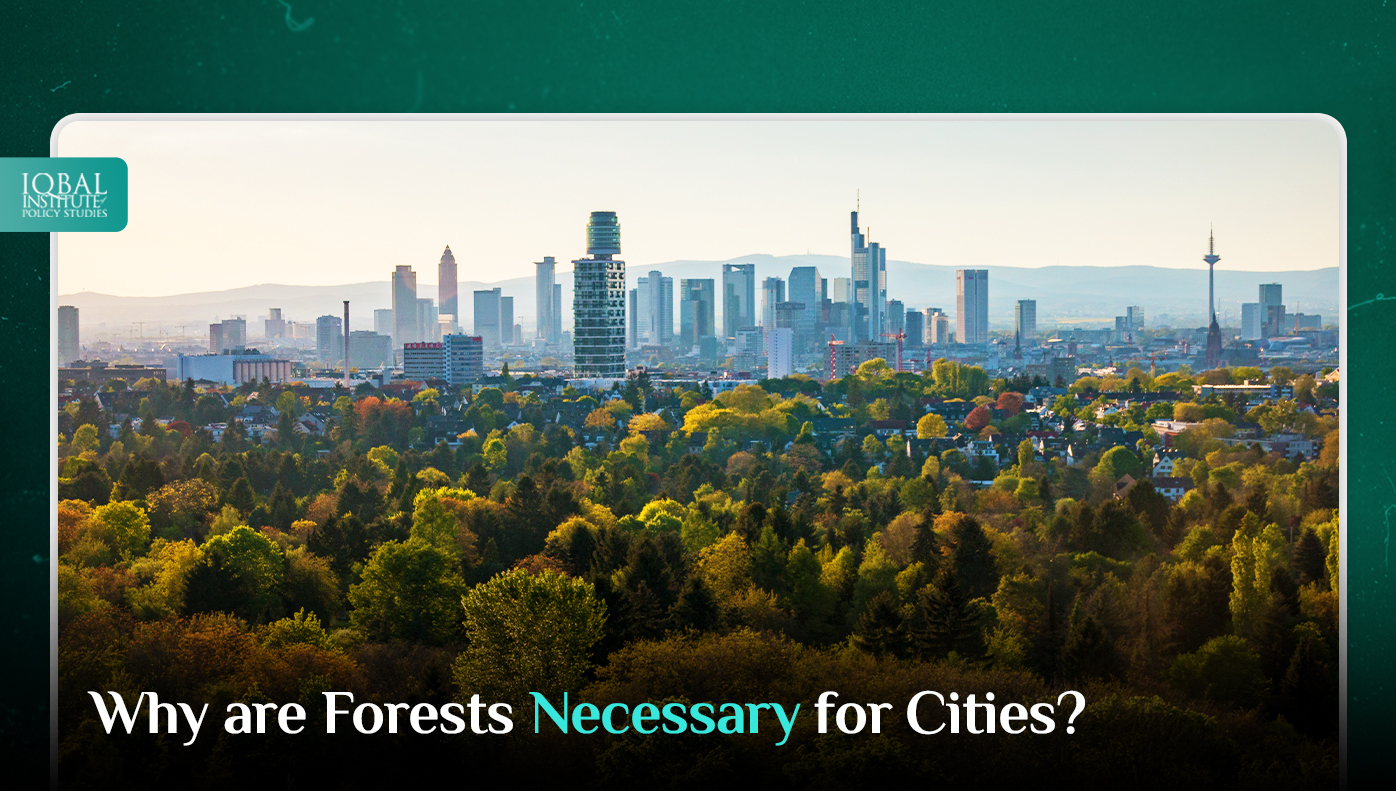Cities are the foundations of the national economy. However, cities’ potential is threatened by unparallel urban growth and an exponential increase in the global urban population. As a result, multiple cities have begun to transition toward a greener, more sustainable, and resilient urban development model by investing in forests. Forests are vital for cities and residents as they provide multiple health benefits, regulate water resources, help combat climate change, and protect global biodiversity. On the surface, cities appear self-sufficient, but most of their resources are derived directly from nearby forests.
Nevertheless, rapid urbanisation in developing nations is without any land use planning strategies, and the resulting human pressure severely affects the forest, landscapes, and green areas in and around cities. Consequently, tree canopies in urban centres are declining. Forest loss and degradation contribute to global greenhouse gas emissions, resulting in rising sea levels, extreme heat events, and intense storms in cities. Therefore, stakeholders should take action to support forest conservation and restoration worldwide. Through intelligent policies, investments and political advocacy, cities can become the frontier of the forest conservation movement at a time when the issue is more urgent than ever.
Benefits of Forests for Cities
Health and Well-Being
Forests can improve the health and well-being of urban residents by reducing extreme heat and enhancing urban air quality by removing less than 1% of the city’s pollution (Wilson, Pool, Phillips, & Alexander, 2022). For example, in Toronto, surface temperatures were below average in cities with a forest canopy cover greater than 70% (Wilson, Pool, Phillips, & Alexander, 2022). Forests and trees also provide opportunities for relaxation and recreation in nature while reducing noise and preventing the spillover of infectious diseases. Furthermore, trees in urban spaces encourage active transport, provide shade, and make streets and pathways more beautiful and pleasurable.
Empowers Community
Most cities face a problem with social and economic inequality. In some cities, lower urban tree canopy cover levels have been linked to low-income and marginalised populations (Wilson et al., 2022). For instance, in Mumbai, protecting mangrove forests has fueled the eviction of slum residents while high-end development in mangrove areas continues (Grinspan, Pool, Trevidi, & Anderson, 2020). Engaging communities in the planning and integrating trees and natural areas into neighbourhoods with marginalised and low-income residents can aid in the reduction of systemic inequalities in urban areas. Moreover, forests and green spaces can build cohesion among urban residents by providing places for communities to gather, creating space for spirituality, recreation, tourism, and contemplation.
Economic Benefits
Forests can raise residents’ property values and generate tax revenue for municipalities. For instance, trees in yards and neighbourhoods can add 3 to 15 per cent to home values (Wolfie, 2022). They can function as a form of “green infrastructure,” lowering stormwater management costs, reducing flooding risks, reducing energy costs, and providing other cost-cutting measures. For example, U.S. urban forests cut electricity consumption by 38.8 million MWh annually, saving consumers $4.7 billion and preventing emissions worth $3.9 billion (Wilson, Pool, Phillips, & Alexander, 2022). Moreover, in Pakistan, the forests contribute 0.43 per cent to the GDP relative to Nepal and India, i.e., 9.45% and 0.67%, respectively. (The World Bank, 2018).
Beneficial for Climate Change Adaption and Mitigation:
Deforestation and forest degradation are responsible for approximately 12% of global greenhouse gas emissions (The World Bank, 2022). The imminent threats of climate change, including heat waves, flooding, rising sea levels, and droughts, endanger urban residents’ well-being and the costs of operating a city. However, forest conservation, restoration, and sustainable management can provide strong, low-cost infrastructure solutions to supplement other traditionally built infrastructure. According to the Intergovernmental Science-Policy Platform on Biodiversity and Ecosystem Services (IPBES), investment in nature-based solutions could contribute about 37 per cent of the climate change mitigation needed by 2030 (The World Bank, 2022).
Stabilises City’s Water Resources:
Many cities struggle to provide safe drinking water, address flooding and erosion, plan for droughts, and deal with erratic rainfall patterns. By 2030, riverine flooding will impact around 130 million people and $535 billion in urban property, and coastal flooding will affect another 15 million people and $177 billion in the urban property (Wilson, et al., 2022). However, forested watersheds near cities regulate water flows and help prevent flooding and landslides. They also reduce local water variability by enabling a slow release of water like a sponge. Also, they play a vital role in stabilising precipitation levels and groundwater availability in a changing climate. Recent Analysis finds that forest protection and restoration can save costs for water utilities in the world’s 534 largest cities by $890 million annually (Wilson, et al., 2022).
Biodiversity
Human activities inside and outside cities contribute to a rapid decline in the biodiversity of plants, animals, fungi, and other life forms. However, cities can benefit from biodiverse forests in a variety of ways. For instance, inner forests act as a carbon sink, protect watersheds, provide blueprints for novel medicines, support urban food supplies and lower the risks of zoonotic and vector-borne diseases. Also, urban forests can have a rich biodiversity and act as migratory routes for some species.
Forests Condition in the Cities of Pakistan
Pakistan is a forest-poor country with only 0.05 ha of forest per capita against a world average of 1.0 ha (National forest products statistics, Pakistan, 2020). It has 4.2 million ha of forest and planted trees, which equates to 4.8 per cent of the total land area (National forest products statistics, Pakistan, 2020). The world has 422 trees on average for every person, but in Pakistan, this ratio stands at around five trees per person (APP, 2021). Summer temperatures in its southern cities often surpass 120°F (Jamro, 2022). Moreover, urban tree cover in Karachi is only 7% (Kumar, 2021). Lahore has lost 70% of forest cover in the last 15 years, which is the biggest reason for the increased smog in the city (Business Recorder, 2020). Islamabad’s urban forest cover was reduced by 17.78% from 1976-2016 (Daily Pakistan, 2020).
Furthermore, climate change is wreaking havoc on Pakistan. Despite contributing only 0.9% of global greenhouse gas (GHG) emissions, Pakistan is one of the most vulnerable countries to the effects of climate change (Government of Pakistan, 2021). Extreme climate-related events are projected to reduce Pakistan’s GDP by at least 18 to 20% by 2050 (The World Bank, 2022). However, urban spaces can be changed to better cope with the inevitable by conscious decision-making on an individual level and by utilising new concepts in landscape design. For instance, 53 Miyawaki forests are being developed in different parts of Lahore (DAWN, 2021), and 300 Miyawaki forests are being developed in Karachi (DAWN, 2021) to create sinks for carbon and better pollution abatement in the city. Also, The Khyber Pakhtunkhwa Urban Forestry Policy has envisaged the plantation of 30,000 saplings to increase environmental sustainability, economic viability and livability of urban settlements of the province (DAWN, 2023).
Recommendations and The Way Forward
Develop an urban forest management plan that should be scientifically informed, inclusively developed, and climate-resilient; the plan should be informed by other citywide plans, such as transportation, housing, land use, parks, and economic development.
Designate land specifically for natural areas, including parks, vacant lots, and along roadways.
Establish relationships with organisations involved in forest conservation, restoration, and sustainable management to help implement efficient forest programs.
Establish ecotourism ventures to conserve and sustainably manage forests threatened by competing land use pressures.
Develop wood waste reuse programs that utilise discarded timber for local industry, construction, and other energy-saving products. These programs help defer costs, create employment, store carbon, and foster integrative thinking and sustainable policies centred on trees in cities.
Ensure every resident has green space within a half mile of the home.
Conclusion
Cities are expanding in terms of size, power, and environmental impact. They face pressing challenges in providing essential services to their residents, such as healthy, livable neighbourhoods, clean and reliable water, climate change action, and access to nature and biodiversity. However, cities can help meet these challenges by utilising trees and forests. This will enhance productivity at the social level and increase economic growth in the long run.
References
APP. (2021, June 28). Pakistan gears up for ‘biggest tree planting drive in history. Retrieved from https://www.thenews.com.pk/print/856081-pakistan-gears-up-for-biggest-tree-planting-drive-in-history
Business Recorder. (2020, November 10). Lahore’s 70pc forest cover lost in 15 years: SAPM. Retrieved from Business Recorder: https://www.brecorder.com/news/40031738
Daily Pakistan. (2020, April 27). Retrieved from Daily Pakistan: https://en.dailypakistan.com.pk/27-Apr-2020/islamabad-s-urban-forest-cover-reduced-by-17-78-percent-from-1976-2016
DAWN. (2021, November 27). 300 urban forests to be set up in Karachi, says Wahab. Retrieved from DAWN: https://www.dawn.com/news/1656364
DAWN. (2021, August 9). ‘This is just the beginning,’ PM Imran on launching Miyawaki urban forest in Lahore. Retrieved from DAWN: https://www.dawn.com/news/1639681
DAWN. (2023, January 27). Urban forestry policy envisages the plantation of 30,000 saplings. Retrieved from DAWN: https://www.dawn.com/news/1733739/urban-forestry-policy-envisages-plantation-of-30000-saplings
Global Forest Watch. (2021). Retrieved from https://www.globalforestwatch.org/dashboards/country/PAK/?category=summary&dashboardPrompts=eyJzaG93UHJvbXB0cyI6dHJ1ZSwicHJvbXB0c1ZpZXdlZCI6WyJ3aWRnZXRTZXR0aW5ncyJdLCJzZXR0aW5ncyI6eyJzaG93UHJvbXB0cyI6dHJ1ZSwicHJvbXB0c1ZpZXdlZCI6W10sInNldHRpbmdzIjp7Im9wZW4
Government of Pakistan. (2021). Pakistan: Updated Nationally Determined Contributions 2021. New York: U.N. Framework Convention on Climate Change. Retrieved from https://unfccc.int/sites/default/files/NDC/2022-06/Pakistan%20Updated%20NDC%202021.pdf
Grinspan, D., Pool, J.-R., Trevidi, A., & Anderson, J. (2020, September 29). Green Space: An Underestimated Tool to Create More Equal Cities. Retrieved from World Resources Institue: https://www.wri.org/insights/green-space-underestimated-tool-create-more-equal-cities
Jamro, N. A. (2022, June 2). Pakistan Today. Retrieved from https://www.pakistantoday.com.pk/2022/06/02/deforestation-hell-in-pakistan/
Kumar, M. (2021, April 21). Will urban forests in Pakistan have a lasting environmental impact? Retrieved from The Third Pole: https://www.thethirdpole.net/en/nature/will-urban-forests-pakistan-have-lasting-environmental-impact/
National forest products statistics, Pakistan. (2020). Retrieved from https://www.fao.org/3/ac778e/AC778E15.htm
The Nation. (2022, December 1). Sustainable tourism is key to poverty alleviation. Retrieved from The Nation: https://www.nation.com.pk/01-Dec-2022/sustainable-tourism-key-to-poverty-alleviation#:~:text=World%20Travel%20and%20Tourism%20Council,contributed%202.9%25%20to%20GDP%20growth.
The World Bank. (2018). Forests for Green Pakistan: FOREST POLICY NOTE. Retrieved from https://openknowledge.worldbank.org/handle/10986/30936
The World Bank. (2022, December 16). Forests and Terrestrial Ecosystems (Landscapes). Retrieved from https://www.worldbank.org/en/topic/forests
The World Bank. (2022, November 10). Pakistan Urgently Needs Significant Investments in Climate Resilience to Secure its Economy and Reduce Poverty. Retrieved from The World Bank: https://www.worldbank.org/en/news/press-release/2022/11/10/pakistan-urgently-needs-significant-investments-in-climate-resilience-to-secure-its-economy-and-reduce-poverty
Wilson, S. J., Juno, E., Pool, J.-R., Ray, S., Phillips, M., Francisco, S., & McCallum, S. (2022). Better Forests, Better Cities. Washington D.C.: World Resources Institute. doi:http://doi.org/10.46830/wrirpt.19.00013
Wilson, S., Pool, J.-R., Phillips, M., & Alexander, S. (2022, November 29). How Forests Near and Far Benefit People in Cities. Retrieved from World Resource Institute: https://www.wri.org/insights/forests-benefit-cities
Wolfie, D. (2022, February 17). Yes, Trees Can Boost Your Property Value—Here Are 10 Varieties to Consider. Retrieved from Real Simple: https://www.realsimple.com/home-organizing/gardening/outdoor/trees-that-boost-property-value#:~:text=According%20to%20Arborist%20News%2C%20larger,15%20percent%20to%20home%20values.



Leave a Reply